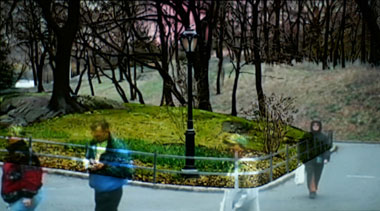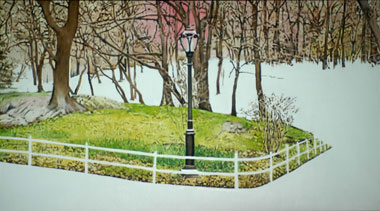 |
| Niamh O’Malley: The dene ‘vignette’ (projection still), 2004, oil on canvas, DVD projection; courtesy Green on Red Gallery |
Amid the glitz and rock video allegories of Sam Taylor-Wood’s last show at the Mathew Marks Gallery (NYC), one work held my attention for longer than I would like to admit. A digital image of a bowl of fruit withered, and decayed, right in front of my ‘very eyes’. Artfully lit (think Chardin) in some corner of Sam’s no doubt awesome studio, the accelerated time-lapse photography seemed to evoke a bygone era, when a camera could be adjusted to make magic. It occurred to me that in this day of ‘post chemical’ imaging, the entire category of the ‘trick photograph’ has been made redundant. But doesn’t every photograph mess with time and play some kind of trick on us?
Niamh O’Malley’s projected work The dene, ‘vignette’, part of PS1’s Visa for 13 exhibition, engaged me in much the way Taylor-Woods Fruit bowl of Dorian Gray did, and without the blue-chip YBA guilt. Modest in both scale and execution (in contrast to the ponderous Doug Aitken down the hall), O’Malley pulls off the rarest of feats in a New York debut; that is: something you’ve never seen before. O’Malley constructs and animates a single image by projecting a short (2 minute, 36 second) video loop of a stationary corner of Central Park onto a canvas (244 x 137cm.) where the same image has been painted to scale. As the two silent pictures dissolve in and out of each other, and odd effect is produced, a shifting between the rendered and the real. There is something mildly irrational about the hold this work has over those who encounter it. Perhaps some secret pictorial rule was broken in allowing this fragment of cinema to operate in the space of painting.
 |
| Niamh O’Malley: The dene ‘vignette’ (projection still), 2004, oil on canvas, DVD projection; courtesy Green on Red Gallery |
O’Malley’s ‘living picture’ hybrid has a slight whiff of the antiquated around it, with all the associated mysteries and pleasures. Sixties ‘underground’ film icon Jack Smith had this great word for describing the undefined, mesmerizing quality that certain films conceal: ‘pastiness’. And The dene, ‘vignette’ is somehow awash in the stuff. How? The selected corner of Central Park depicted is generic, but not sentimental in any Hallmark Card kind of way. Maybe it’s the plumb-colored sunset and the ‘hand painted’ quality of the brushwork, like something you’d find on a treasured ceramic piece. Usually, when the ‘hand’ gets involved with the photograph, busywork and excess ensues; take the Starn Twins, for example. O’Malley’s use of paint on canvas is, to my knowledge, unprecedented in the crowded field of what is referred to as the ‘cinema of exhibition’. It is also the specificity of the situated canvas that differentiates O’Malley from those who plunge costly Chelsea real estate into darkness simply to show movies on the walls.
It should be said that I am also a sucker for any park image, ever since being caught in Blow Up ‘s lush sway that evening in 1966. If this ‘movie’ has a star, it’s the faux ‘turn of the century’ lamppost that occupies the center of the frame, much like the Empire State Building did in another epic of dislocation, Andy Warhol’s Empire of 1966.
But instead of sublime boredom, the seamless continuum of this urban pastoral invites scrutiny. Ghostly passers-by and other marginalia function as markers in any attempt to measure how long we have spent looking. I recall a character in a Kurt Vonnegut novel who, having become ‘unstuck in time’, careens between nightmare and idyll. With the projection as the only light source and with no curtains to part in the doorway, the gallery’s small space was unusually welcoming and ambient; people who came in tended to stay and interact.
 |
| Niamh O’Malley: The dene ‘vignette’ (projection still), 2004, oil on canvas, DVD projection; courtesy Green on Red Gallery |
Is it that lamppost that signals the way back, to cinema’s prehistory, for relevant precedents? The camera obscura would be an obvious precursor [1] but a more intriguing example is found in Victorian-era ‘Magic Lantern’ shows. Audiences were both amused and mystified by images projected from a kind of stone-age slide projector. Desired effects were achieved by using retouched overlays (early ‘mattes’), dissolves, and even by jiggling the projector. Should we then add O’Malley’s name to the list of contemporary artists who employ twenty-first-century technology to address nineteenth-century concerns? Jeff Wall’s moralizing duratran friezes, Mathew Barney’s DVD dream worlds, and Justine Kurland’s group portraiture comes immediately to mind. By taking us back to the flickering origins of the motion picture, O’Malley relieves us from the responsibility of finding a narrative drive in what we see. Free of this burden, we are allowed to drift; minus that ‘arrived too early or too late’ feeling that attends the majority of gallery / cinema experiences. With The dene, vignette the surface of a canvas unexpectedly plays host to both the fact of the camera and the fiction of the hand. And as it did for one swinging London photographer, it is a single image of a park that holds us in thrall.
Tim Maul is an artist who lives in New York City. He teaches at The School of Visual Arts and contributes criticism to ‘afterart’ (Paris)
[1] Tanya Kiang, Dark wonder,. CIRCA 96, Summer 2001, pp. 22-24